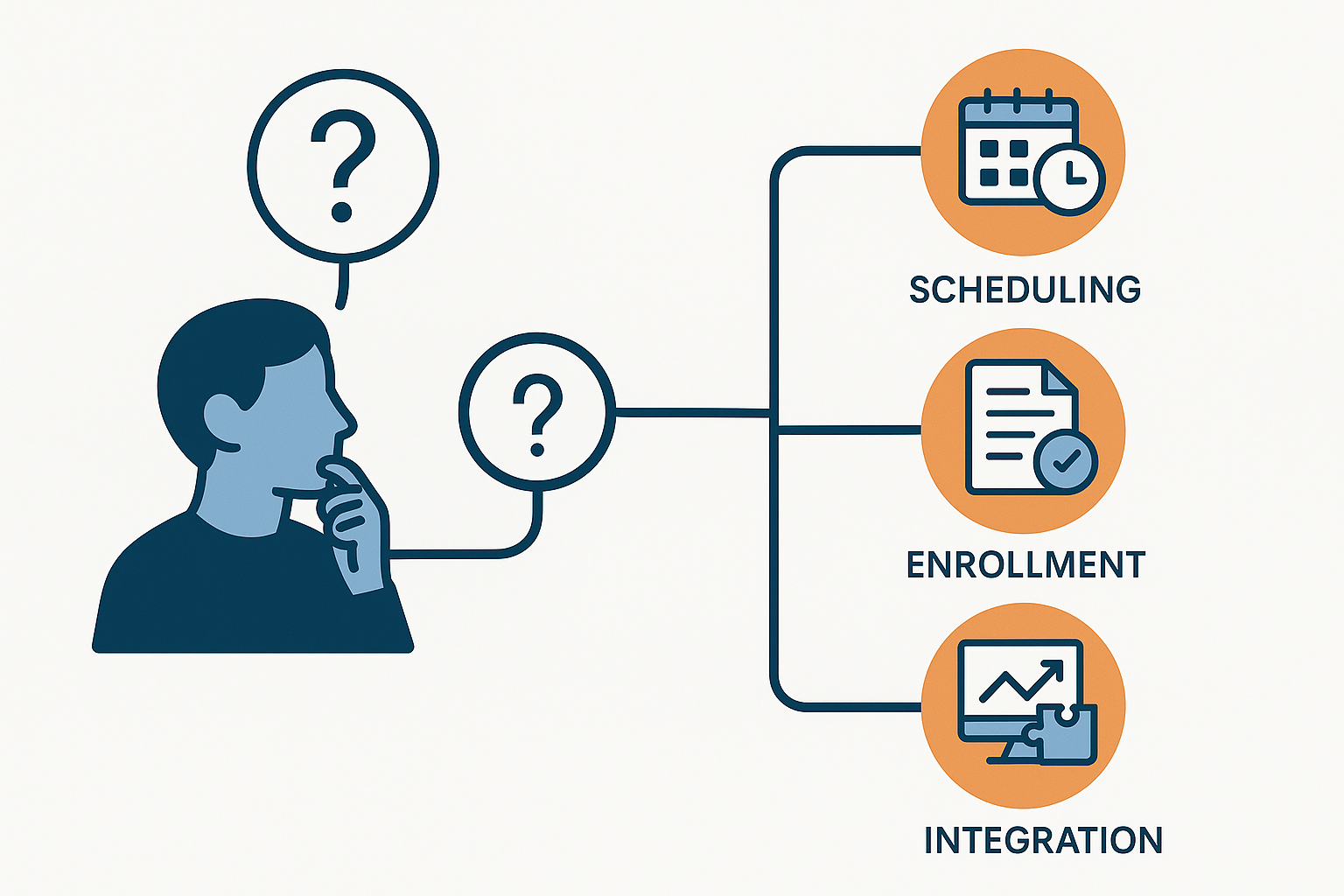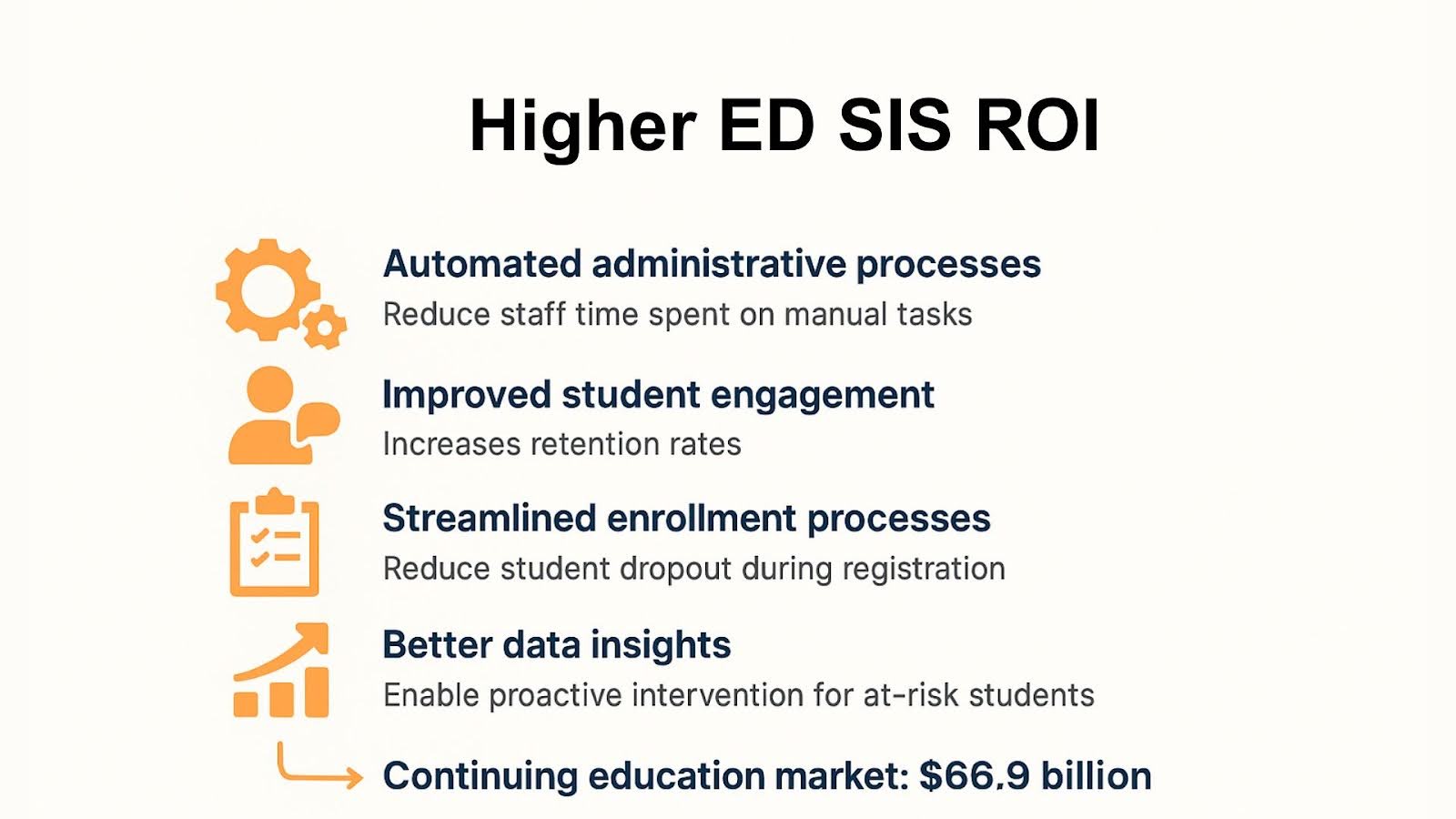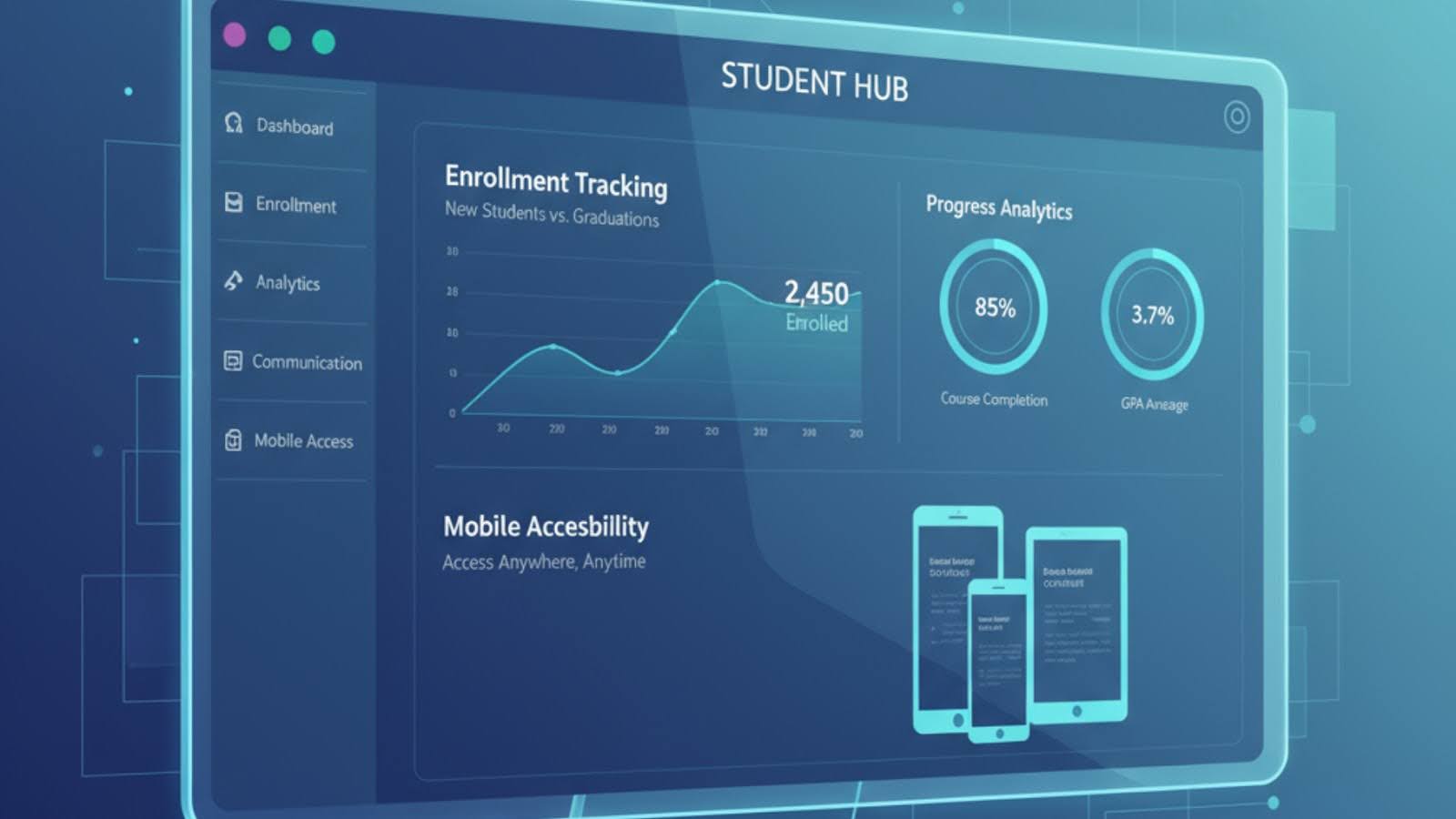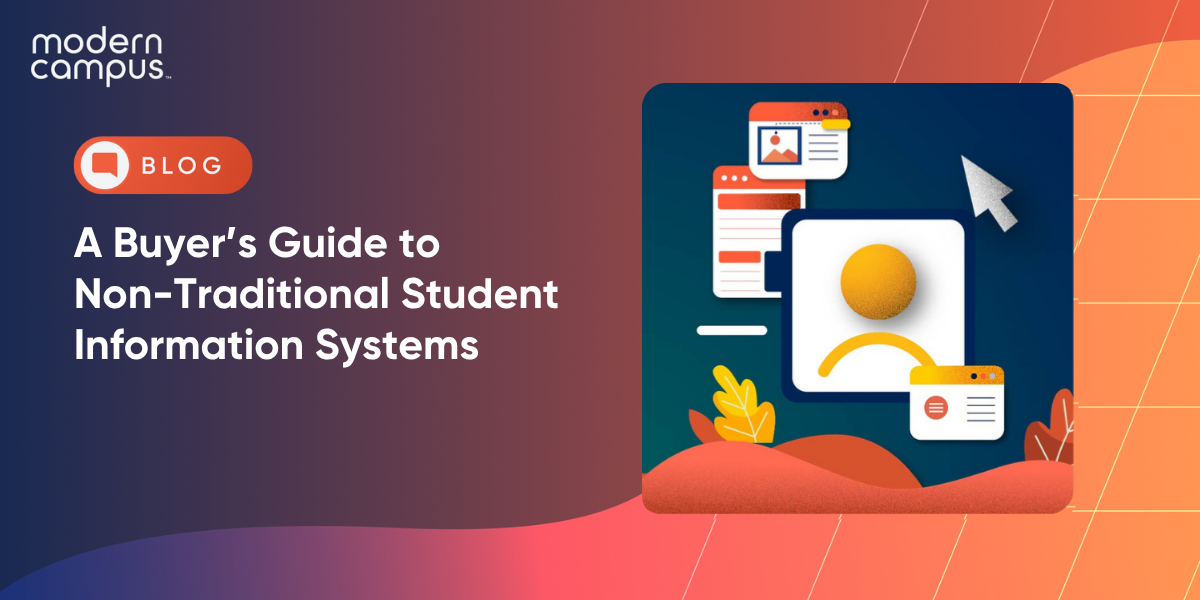A Buyer’s Guide to Non-Traditional Student Information Systems
Non-traditional student information systems are essential for managing the 73% of undergraduate students who have non-traditional characteristics and the growing continuing education market.
- Market growth is explosive: The student information system market reached $17.3 billion in 2025 and is projected to hit $45.1 billion by 2032.
- Student demographics are shifting: Non-traditional learners now represent a significant and growing portion of higher education enrollment.
- Integration is critical: The best systems seamlessly connect with career pathway tools, LMS platforms, and workforce development programs.
Choose a student information system built specifically for non-traditional learners with flexible enrollment, automated workflows, and comprehensive lifelong learning support.
The student information system market has experienced tremendous growth, reaching $17.3 billion in 2025 and projected to grow at a 14.7% CAGR to $45.1 billion by 2032. This expansion is driven primarily by increasing demand for flexible, career-focused education and the rise of non-traditional student populations.
Carefully choosing a non-traditional student information system is vital for institutions that serve diverse learners with unique needs. The right system helps colleges and universities adapt to changing educational trends and stay competitive in effectively serving non-traditional students. Selecting the right higher ed SIS also supports scalability, compliance and long-term operational efficiency.
What Is a Non-Traditional Student Information System?
Student information systems (SIS) are essential for managing the complex environment of higher education. These platforms serve as the backbone for handling everything from student records to data management, making life easier for administrators and enriching the student experience.
Non-traditional SIS are software platforms designed to manage and support the academic and administrative needs of non-traditional students, such as adult learners, part-time students, online learners or those returning to education after a gap. These systems are tailored to handle flexible schedules, diverse learning formats and unique student records, offering features like tracking modular coursework, supporting asynchronous learning and managing multiple enrollment periods. They go beyond standard SIS capabilities to accommodate the specific needs of students who follow non-conventional educational paths.
Why Are Non-Traditional Student Information Systems Essential for Higher Education?
Institutions face numerous challenges, including heavy staff workloads and the need for more efficient processes, all while meeting students' changing needs. Higher education is shifting toward serving more diverse learner populations, with non-traditional students representing a growing segment of enrollment.
Non-traditional academic management software offers several key benefits for institutions, especially those serving diverse and flexible learning populations.
Personalized Learning Experiences
These systems can cater to the unique academic needs of non-traditional students by supporting varied course structures, modular programs and self-paced learning. Unlike traditional systems designed for linear degree progression, non-traditional student information systems accommodate diverse educational pathways and individual learning goals.
Enhanced Flexibility for Diverse Schedules
Flexibility allows students to manage non-standard schedules, multiple enrollment periods and asynchronous classes more effectively. Non-traditional learners often balance work, family and education simultaneously, requiring systems that can handle rolling admissions, part-time enrollment and varied course formats without creating administrative bottlenecks.
Improved Student Retention
Non-traditional student management systems improve retention by providing better support for tracking progress, offering personalized advising and improving communication channels with students. College dropout rates average 32.9% for undergraduate students, making retention improvements through better student management a substantial revenue driver.
Targeted Marketing and Recruitment
Marketing to nontraditional students is essential for institutions, as this growing demographic represents a significant opportunity for enrollment growth and revenue while also addressing workforce development needs. An SIS assists with targeted marketing to adult learners by collecting and analyzing data on learner demographics, preferences and enrollment patterns. Institutions can craft personalized marketing messages that resonate with their specific needs for flexible schedules, career advancement and online learning options.
Scalability and Compliance Management
Institutions also benefit from scalability and compliance management, as these systems are designed to adapt to evolving educational models and ensure adherence to educational standards and regulations. This scalability is particularly important as institutions expand their non-traditional offerings and need to maintain consistent data management across diverse program types.

A non-traditional student information system is a critical tool for managing the complex environment of higher education. It simplifies administrative tasks and improves the student experience by ensuring data is handled securely and efficiently. The ultimate result is better student satisfaction, higher retention rates and improved operational efficiency.
What Challenges Do Institutions Face When Supporting Non-Traditional Students?
Higher education faces several challenges when managing non-traditional students. Flexible scheduling is a must for these students but is not always offered by institutions. Non-traditional students are balancing work and family responsibilities along with other life commitments, requiring institutions to offer varied class times, learning formats and asynchronous content.
Student engagement can also be more difficult to maintain with non-traditional students, as these learners may feel disconnected from the campus experience, necessitating more personalized and flexible support services.
The growing demand for flexible, career-focused education creates both challenges and opportunities for institutions. Non-traditional students require specialized support systems, but institutions that successfully serve this population gain access to a substantial and underserved market of lifelong learners seeking relevant credentials and career advancement.
Retention and completion rates are another concern, as non-traditional students may take longer to finish their degrees or drop out due to external pressures. Institutions must implement targeted retention strategies, including academic advising and financial aid tailored to their specific circumstances.
Administrative complexities are increased due to managing non-standard enrollment cycles, credit transfer needs and part-time attendance, which can place strain on traditional student management systems. Lastly, ensuring that non-traditional students feel adequately supported requires rethinking access to resources like academic counseling, childcare and career services, as these students often have different priorities and challenges than their traditional counterparts.
How to Choose the Right Non-Traditional Student Information System
Choosing the right student management system can be overwhelming. A robust system should offer personalized student tracking and support, ensuring that non-traditional learners receive tailored advising and retention services. Additionally, your higher ed SIS must integrate with online learning platforms, allowing students to access resources remotely and on demand. The ability to scale and adapt to evolving educational models, such as hybrid or competency-based learning, is equally important.

Here are key factors to consider when selecting the right platform:
What Should You Assess Before Choosing a System?
First, evaluate several critical factors to understand your institution's specific requirements. For instance, analyzing student demographics can help you understand learners' unique needs, such as flexibility in course schedules, modular learning paths and asynchronous learning options. Then, consider administrative capabilities to ensure the academic management software can handle non-standard structures like rolling admissions, part-time enrollments and credit accumulation over time.
Integration with existing tools, such as LMS and financial aid platforms, is also a key consideration to guarantee seamless operations. Institutions need to assess scalability to ensure the system can grow with their student population and meet future demands. They also look for robust compliance and reporting features to meet regulatory requirements. Finally, evaluate user experience for both students and administrators in order for the system to enhance engagement and operational efficiency.
Consider these essential assessment areas:
- Administrative Tasks: Identify which tasks need automation
- User Requirements: Consider the needs of administrators, teachers and students
- Compliance: Ensure the system meets state and federal reporting requirements
How Can a Student Information System Support Targeted Marketing to Non-Traditional Students?
Many institutions will traditionally market to graduating high school students, but these messages don't always resonate with non-traditional learners. An SIS can play a pivotal role in marketing to non-traditional students by leveraging data-driven insights to create more targeted, personalized campaigns.
Look for a system that collects and stores detailed data on students' demographics, enrollment patterns and preferences, enabling institutions to segment potential non-traditional learners based on factors such as age, career stage or learning format preferences. With this information, institutions can craft tailored marketing messages that match the specific needs of non-traditional students.
Additionally, a higher ed SIS can help track the effectiveness of marketing efforts by monitoring student engagement and application trends in real time. Institutions can refine their marketing strategies quickly and focus on channels that yield the highest return on investment.
Integrating the student information system with Customer Relationship Management (CRM) tools further enhances the ability to nurture leads, personalize communication and build long-term relationships with prospective students, ultimately increasing enrollment of non-traditional learners.
What Features Support Continuing Education and Workforce Development?
Choosing the right student management system to support continuing education and workforce development for non-traditional students requires evaluating several key features and functionalities tailored to the unique needs of adult learners and professionals.
Flexible Scheduling and Enrollment: Look for a system that can handle rolling admissions, non-term-based enrollments and flexible course schedules to accommodate students balancing work, family and education.
Modular Learning and Credentials: Your academic management software should support modular coursework, allowing learners to accumulate credits toward larger qualifications over time. It should also provide detailed tracking of credentials earned and skills developed.
Career and Workforce Alignment: Choose a student information system that provides tools for aligning educational programs with workforce demands. Consider features that track job placement, internships and partnerships with employers, ensuring that learners are gaining skills that directly support their career goals.
Compliance and Reporting: Many workforce development programs need to comply with specific regulations or reporting standards. The system should offer strong compliance features, including the ability to track student eligibility, financial aid and report outcomes to regulatory bodies.
How Does a Student Information System Support Career Pathways?
Modern non-traditional learners increasingly seek education that connects directly to career advancement. A comprehensive student information system should integrate career pathway functionality that helps students understand job market opportunities and make informed decisions about their educational investments.
The best systems incorporate real-time labor market data, including salary insights and growth opportunities, helping students choose programs that align with career goals. This integration transforms education from a theoretical pursuit into a strategic career investment.
Career pathway features should include job market outlook data, program-to-career mapping and detailed information about required skills and certifications. When students can see clear connections between their coursework and career outcomes, engagement and completion rates improve.
What ROI Can Institutions Expect from Modern Student Information Systems?
The financial impact of choosing the right student information system extends beyond initial implementation costs. Modern academic management software delivers ROI through several key areas:
- Automated administrative processes reduce staff time spent on manual tasks
- Improved student engagement through personalized communication increases retention rates
- Streamlined enrollment processes reduce student dropout during registration
- Better data insights enable proactive intervention for at-risk students
- Enhanced marketing capabilities improve enrollment conversion rates
Given that the continuing education market alone has grown to $66.9 billion, institutions with modern student management systems are better positioned to capture this expanding market opportunity.

How Important Is Scalability?
Your chosen system should grow with your institution.
- User Capacity: Ensure the system can handle an increasing number of users.
- Feature Expansion: Look for a system that allows for feature upgrades and additions.
- Integration: Choose a system that can integrate with other tools you might adopt in the future.
Scalability ensures the system can adapt as the institution grows in both student population and operational complexity. User capacity is a key factor, as non-traditional institutions often experience fluctuating enrollment patterns. This requires a higher ed SIS to easily support an expanding user base without compromising performance.
Additionally, feature expansion is vital, as institutions may need to integrate new functionalities such as hybrid learning tools, personalized student support systems or enhanced reporting capabilities as their programs evolve. Seamless integration with other educational platforms and third-party communication tools ensures the student information system can adapt to the institution's broader digital ecosystem.
This scalability supports long-term growth and ensures that both administrative and academic functions can evolve alongside the institution's changing needs.
What Level of Support Should You Expect?
Reliable support is key to smooth operations in higher education. When issues arise, quick and effective help ensures that everything runs as it should. Staff can focus on helping students instead of fixing problems. It also keeps students happy and engaged, making them more likely to succeed and stay connected with the institution.
Key support considerations include:
- Technical Support: Check if the vendor offers 24/7 support
- Training: Ensure comprehensive training is available for staff
- Community and Resources: Look for a vendor with a robust user community and plenty of resources, like user guides and FAQs
By considering these factors, you can choose a non-traditional SIS that fits your institution's needs, budget and future growth plans.
Essential Features Every Non-Traditional Student Information System Should Include
When evaluating student management systems for non-traditional learners, certain features are non-negotiable for success. These capabilities directly address the unique challenges that adult learners face while supporting institutional goals for growth and efficiency.

Automated Enrollment and Registration Workflows
Non-traditional students expect the same seamless digital experiences they receive from other industries. Modern systems should automate time-consuming processes like enrollment, payment processing and course registration, reducing friction and improving completion rates.
Flexible Program Management Capabilities
The ability to manage diverse program structures, from micro-credentials and certificates to degree completion pathways, is essential. Students should be able to stack credentials over time, with the system tracking progress across multiple programs and timeframes.
Comprehensive Reporting and Analytics
Data-driven decision making requires robust reporting capabilities. Look for systems that provide insights into enrollment trends, student progress and program effectiveness. These analytics help institutions identify opportunities for improvement and demonstrate ROI to stakeholders.
Mobile-Optimized Student Experience
With adult learners often managing education alongside work and family responsibilities, mobile accessibility is vital. The system should provide full functionality through mobile devices, allowing students to register, access materials and track progress from anywhere.
Frequently Asked Questions
What makes a student information system suitable for non-traditional students? A system designed for non-traditional students should handle flexible scheduling, rolling admissions, modular coursework and diverse learning formats. It should also support career pathway integration and provide robust analytics for tracking student success across varied program structures.
Can a non-traditional student information system integrate with existing campus technology? Yes, modern systems are designed for seamless integration with LMS platforms, ERP systems, CRM tools and other campus technologies. This connectivity ensures data consistency and provides a unified experience for both students and staff.
What support should institutions expect during implementation? Look for providers offering comprehensive training, 24/7 technical support and dedicated implementation specialists. The best vendors provide ongoing professional development opportunities and maintain active user communities for peer learning and best practice sharing.
How do these systems help with compliance and reporting requirements? Modern academic management software includes built-in compliance features for educational standards and regulatory requirements. They provide automated reporting capabilities, audit trails and data security measures that meet or exceed industry standards like PCI-DSS and SOC-2 compliance.
Choose a Student Information System Partner Committed to Your Success
Choosing the right non-traditional student information system is essential for success in higher ed. A seamless learner-to-earner lifecycle means supporting students and their unique needs throughout their educational journey.
Technology for higher education should meet the needs of today's learners by focusing on creating efficient, user-friendly systems that simplify data management and improve the student experience. With 68% of adult learners preferring non-degree education options, institutions need specialized tools to effectively serve this growing market.
Modern Campus offers a robust non-traditional academic management software solution that integrates smoothly with other tools and platforms. All your data is in one place and easily accessible. Our SIS changes the way institutions operate and support non-traditional learners. Request a demo today to transform your institution with the best non-traditional student information system.
Last updated: November 5, 2025
